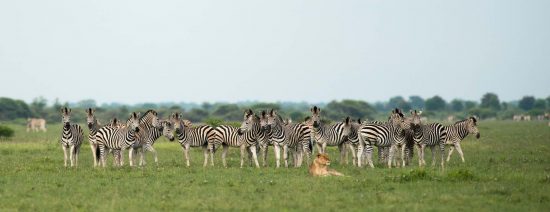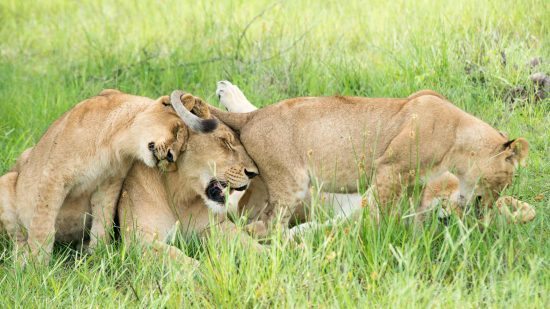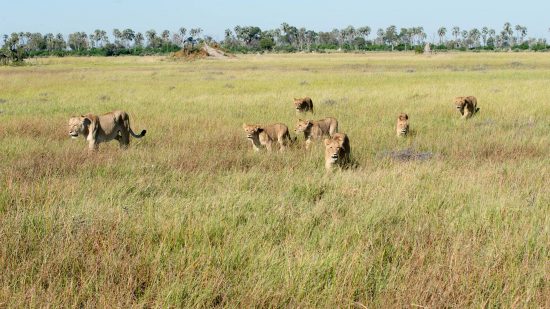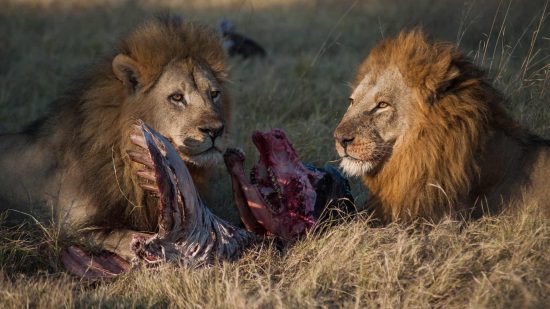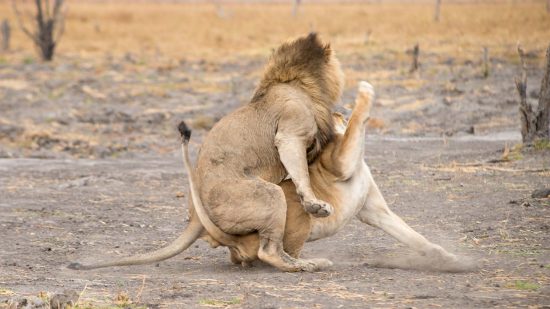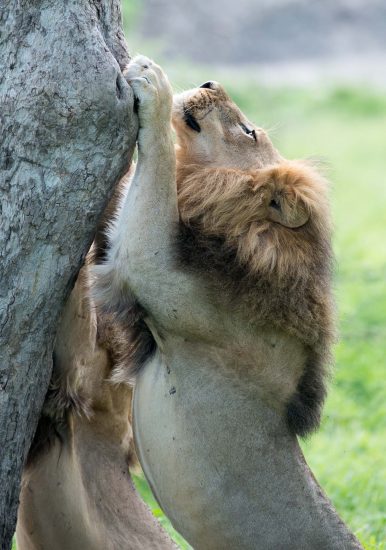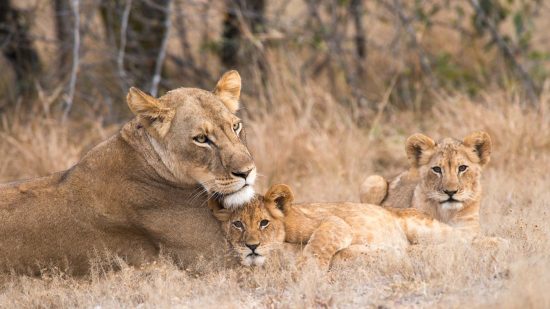
LION BEHAVIOR FOR PHOTOGRAPHERS
by Christiaan Winterbach May 2020
I am a wildlife biologist that has worked for 25 years in northern Botswana, mostly in and around the Okavango Delta. My focus has been on counting large carnivores, especially lions. Sharing a passion for carnivores and photography, I have spent more time with lions than most people.
Introduction
Going on a once in a lifetime safari, you don’t want to lose key photographic opportunities. The advantages that professional wildlife photographers have over a first-time visitor, are local knowledge and an understanding of the animals. Knowing where to find animals and when they are going to do something improves your chances to get that special photo. A good guide will go a long way in providing local knowledge. I hope this will help you with some basic understanding of lions and not to miss the shot! Leopard tail
People associate lions with the African savannah, but they use from the deserts to the edge of tropical forests, and everything in between. Lions are social cats, living in prides consisting of related females and their offspring. Prides frequently spend time apart in sub-groups.
New males will take over as pride males from time to time. The coalition of pride males mostly consists of 1 to 3 males. The males are dominant over the females and aggression is a normal part of lion social interaction.
Behaviour
In general, lions do not do much: they can on average sleep over 20 hours per day! Therefore, you need to get your timing right. Sleeping lions The good news is that they are more active in the golden hour. The hotter it is, the less likely they are to do something. Waiting for lions to do something that you can photograph is best done without non-photographers!
The typical lion day starts late afternoon/ early evening. It is time for grooming and ablutions. This is a peak time for interaction between individuals: cleaning and rubbing against each other and flopping down on top of each other. Cubs like to play. A bit later the group will set off hunting. They will spread 3 to 4 hours of activity through the night interspersed with frequent naps, before starting their daily nap. On cold winter mornings, they like to find a nice spot in the sun, until it becomes hot. On cool overcast days, they may be active for longer.
The males frequently leave the females on their own, to go and patrol their home range. They scent mark by spray painting bushes with urine and leaving feces, to deter intruders. When sub-groups of the same pride meet up, there is a lot of greeting. Encounters with nomadic lions or neighboring prides are tense and frequently become hostile between same sexes.
Both sexes roar and it can be audible up to 8 km (5 miles) to humans at night.
Lions prefer medium to large prey but will catch smaller animals opportunistically. They don’t mind scavenging food from other predators. Lioness eyeing warthog A fresh kill and hungry lions equals conflict. It is everyone for themselves, with the males ruling. Lots of action. From growling to short skirmishes. A pride member that’s late for dinner will restart the squabbles. Cubs can get injured.
A big kill like a buffalo or giraffe will last the lions a couple of days. Generally, the lions will try to pull the kill into bushes where the vultures won’t see it. They will stuff themselves and then replenish themselves regularly afterward; being most active at dusk and dawn. After a day or two, you should make sure to approach and stay upwind of the kill. Volstruis reeks Hyaenas and jackal will start hanging around. The hyaenas will wait for their chance to take over the kill from the lions.
Lust overrides heat! (Mababe) Mating happens over a four-day period with the pair mating on average every 15 to 20 minutes. Initially, the male is very eager, but on day 3 less so. The female will initiate mating, by flirting and presenting herself. The action lasts about 15 seconds before the male dismounts. Male demounts on the same side each time – giving you a good idea of where to expect the action. You don’t want to miss the dismount; the male growls and some females go aggressive on the male. Female response varies a lot in intensity between individuals. Some merely flop over. If you miss it, wait 15 to 20 minutes for the next chance.
Good anticipation of coming events helped me a lot in the past. We were sitting with a pair of mating lions. The rain was drizzling down and eventually stopped. I was waiting for the male to shook the rain from his mane. My friend missed the shot. Eventually, the lions mated. We didn’t have the best view. They moved about 50 m to a new spot. We got into a good position. The female was facing us straight. The male approached and sniffed her behind. Two hours of being wet and cold, but now we had the perfect view. I pre-focused on her face. She whipped around, and slapped him a couple of times to say “No more!! This is over!”. It happened so unexpectedly and quickly that I forgot to focus (back button), and only regained focus as the male gave a final roar and walked away. I anticipated a normal mating, but we saw the last one 20 minutes earlier. My friend got the shots!…on a Sony. And that is why there is a Sony photo on a Nikon Rumors post! I deeply apologize…
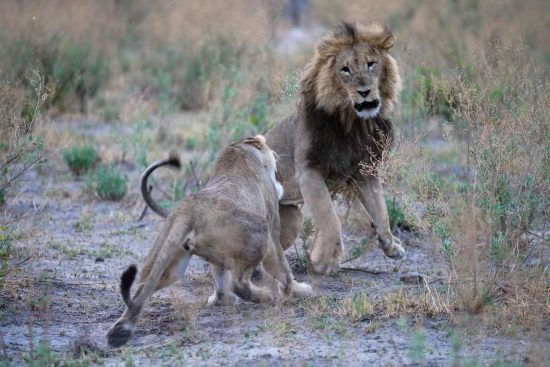
Interaction with other species
Any other carnivores will get a response from the lions, even small carnivores. On the herbivore side, it is mostly buffalo and elephant that will take on the lions.
African wildlife has various tools to rearrange you in multiple ways. This section is not meant to be your all-in-one safety course, I am merely pointing a few things out. I could start this section by saying “Use your common sense”. Unfortunately, common sense is quite rare. So, I’ll start with “Trust your guide, he is probably the most experienced person in your group”.
We were discussing safety when darting lions. My vet friend summed it up perfectly: “When things go wrong, it will change our lives forever”. The photo is not worth your life!
You get various types of lions, genetically speaking and otherwise. The otherwise bit is what should concern wildlife photographers. Most tourists are only exposed to Safari lions; these are the lions that are used to game drive vehicles and people on these vehicles. These lions mostly ignore the vehicles and people. So, after a day or two on safari, you might think you have the hang of this. We do like to generalize. The problem with animal behavior is, that it is the exception that’s going to bite or stomp you!
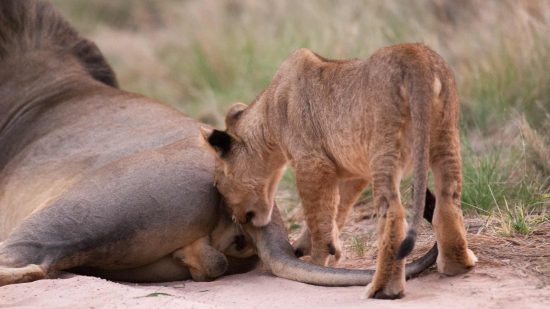
Off the beaten track, lions have far less contact with people and vehicles. These lions are more skittish and more likely to be aggressive. Don’t mess with lions in areas with high levels of human-wildlife conflict. The same lion that is moving away from you today, is the one that will show no fear tonight!
The most dangerous wild lions are man-eaters. They have zero fear for humans and see us as food. Luckily there are only a few areas where that might be a problem. In general, the most dangerous lion that the tourist would be exposed to is hand-reared lions at various “rescue” and “conservation” facilities that offer cub petting and walking with lions. Teenage males are the worst.
It is worthwhile to know some indications that a large predator is not happy. The first indication is that they look uncomfortable, then the ears are pulled back and the tail starts whipping. Getting out of there is recommended at this point. If you can’t get out of there, sit still and quiet; don’t look the animal in the eye. This will escalate to growling, followed by a mock charge. But don’t bet on it that it would be a mock charge.
May you get many good lion photos, and remember, lions did not read the book. Sometimes they will do the unexpected!
If you have an interesting idea for a guest post, you can contact me here.
